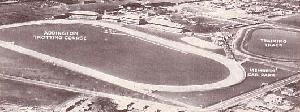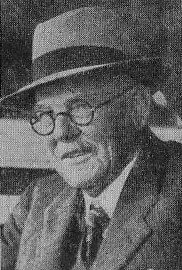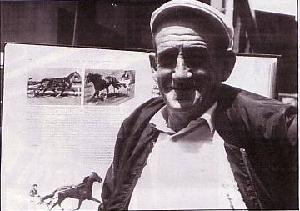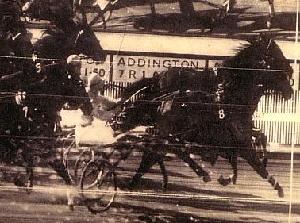| RACING HISTORY |
YEAR: 1950
THE BEGINNINGS
NZ TROTTING ASSOCIATION
When in August the NZ Trotting Association is finally absorbed by the NZ Trotting Conference, it will have completed 50 years of service to the sport.
The late Mr C S Howell, an early administrator of trotting, worked with the late Mr A I Rattray and others toward the amalgamation of the North Island and South Island Trotting Associations, and thus, in 1899, came into being the NZ Trotting Association. Mr Howell also became chairman of the first NZ Trotting Conference.
Mr Rattray, who was largely responsible for the formation of the NZ Trotting Association, is still regarded by the people who knew him over a long period of years as the "father of trotting". He left behind him a record of service that time will not obliterate. Trotting will always be in the debt of this fine old pioneer, who, incidentally, was the first secretary of the NZ Trotting Conference.
The late Mr Phineas Selig, who was president of the Association from its inception until his retirement in 1925, was responsible for many reforms. Perhaps his outstanding contribution to the light-harness fabric was the fathering of the rule makng it obligatory for all clubs to include two events for trotters on an eight-race programme.
First elected to the board in 1916, the late Mr J H Williams became chairman in 1925 and remained in that position for 14 years, until shortly before his death. He was held in the highest regard by his colleagues and all who came in contact with him and he made a notable contribution to the administrative side of the sport.
The late Mr H W Kitchingham was a member of the board of the NZ Trotting Association for the record period of 35 years and was chairman from 1939 to 1945. He was primarily responsible in 1938 for a revised edition of the Rules of Trotting.
President of the Association from 1945 to 1947, the late Mr R B McCarthy, of Hawera, joined the board in 1943 and retired, through ill health, in 1947. A leading figure in the legal profession in Hawera, he was an outstanding member of the board, and earned respect throughout the Dominion for his impartiality and sound administrative qualities.
Mr J B Thomson, who succeeded Mr McCarthy as president, was a member of the board for 23 years. Mr Thomson has a profound knowledge of horses and the men who drive them. He has a keen sense of proportion and a lively sense of humour, attributes that have endeared him to all sections of trotting over a lengthy period.
Sir John McKenzie, treasurer to the NZ Trotting Association over a lengthy period, is offering himself for election as treasurer to the NZ Trotting Conference. Sir John was also chairman of the Licensing Committee for a number of years, and altogether served 25 years on the board.
Mr H F Nicoll, later to become president of the NZ Trotting Conference, a position he held with ever-mounting distinction for a quarter of a century, was a member of the board for a term.
The late Mr W Hayward, a vice-president for many years, the late Mr H C Harley, the late Mr S W Kelly and Mr J M Samson, were other members of the board of the last two decades who served for long periods.
Mr E A Lee, now a Stipendiary Magistrate, was a member of the Association from 1943 to 1948, and there was genuine regret among trotting people when his services as an administrator were lost. He was obviously marked out for high office in the trotting world.
With trotting in Auckland will always be associated the name of the late Mr C F Mark, who was a member of the board for many years. He was one of the dominating personalities of his day, and Sir John McKenzie remembers Mr Mark as one of the most able men on the board at the time he (Sir John) was first elected to it.
The late Mr R A Armstrong, of Wellington, although he did not take high office on the board, is remembered as a man of gifted oratory and sound judgement. He was recognised as a born organiser and he was actuated by a genuine desire to see trotting prosper.
Apart from Sir John McKenzie and Mr J B Thomson, the member of the board with the longest record of service was Mr W M Ollivier, an indefatigable worker for the sport.
Credit: 'Ribbonwood' writing in NZ Trotting Calendar 21Jun50
YEAR: 1950
ADDINGTON TROTTING GROUNDS
 |
Credit: NZ HRWeekly 26Jun91
YEAR: 1950
BUILDINGS & FACILITIES
1950 CUP DAY TOTAL A RECORD
The return of NZ Trotting Cup day to the traditional Tuesday of Carnival Week proved an unqualified success. All the forebodings of the timorous that mid-week racing would decimate the totalisator returns proved groundless, the total of the day, £211,977, being a new record for a days racing in the South Island and also a record for a trotting meeting. Of this sum, £15,278 was invested on the double.
Addington, recognised as the NZ headquarters of trotting, looked better on Tuesday than it has ever looked before. The scene was gayer than ever. Many thousands of people continue to make Cup day at Addington their 'day of the year.' The previous record attendance at any fixture, apart from international rugby tests at Lancaster Park, was recorded on Cup Day last year, October 29, a Saturday. The crowd was 34,000, and the then record total of £211,293 was established, £40,717/10/-being invested on the Cup alone. The year's Cup total was £40,203/10/-, a result far exceeding the expectations of even the most optimistic.
Many workers took the day, or part of it off, and in a number of factories employees requested time off and promised to make it up by working extended hours at ordinary rates. Before 1942, when the Cup was always run on a Tuesday, thousands journeyed to Addington for a two-hour lunch break to see the Cup and one other race, but this year the Cup was not run until 2:17pm. When the 1941 Cup attendance of 19,000 is compared with crowds of more than 30,000 this year and last year, the great strides in the popularity of trotting in Christchurch are measured. The trainers and drivers in trotting are public personalities, and the horses, their breeding, their performances, their best times, and their characteristics are as the A B C to all followers. With races being held on a six-furlong track, the horses are in view without the use of binoculars - except for those not endowed with height jammed in the crowd - and the intimacy of trotting at Addington is one of the causes of the phenomenal increase in popularity with the public.
Additional betting facilities were available on Tuesday, additional turnstiles have greatly reduced the length of queues, and a large marquee erected on the lawn enclosure behind the main stand has improved the catering appreciably. A scheme of tree-planting and attractive gardening displays give the whole scene a pleasant 'new look' and this part of the club's plan is only in its infancy.
To give all patrons a clearer hearing of the commentaries on the races by Mr D B Clarkson (now established as a notable contributor to the enjoyment of a day at Addington) all the loud speakers have been brought across the tracks to the outer fence and a new loud-speaker has been placed on a pole on the lawn inside the track to provide for the thousands who watch the races from there on Cup days. Men to open the gates and rake the track from the outside enclosure are always on duty at meetings at Addington, but the general public do not seem to realise that the inside of the course is always available to them. The inside enclosure is now one huge lawn, the section at the top end having been levelled and grassed.
The grey drabness of the concrete of the stands had largely disappeared under a spray of plastic paint. All the stands would have been painted by now had the supplies of the paint been available.
Another work of priority which could not be carried out before the Cup meeting was the building of semi-permanent seating on the mound in front of the tea kiosk, wittily called by patrons 'Coopers Knob,' after the course superintendent and the prominent landmark on the Port Hills. The open stand will seat about 2000.
"The people would see on Cup day the progress we are making to give them the best facilities." said the president of the NZ Metropolitan Trotting Club, Mr C S Thomas. "We are only beginning a long-term programme to make Addington the finest possible trotting course." As the administrative head of the Metropolitan Trotting Club, Mr H E Goggin is responsible for every detail. The totalisator manager (Mr Arthur Toon) had a staff of 423 on Tuesday, and the other workers on gates, stairs and cloakrooms number 180. In addition, 450 were working on catering.
Credit: NZ Trotting Calendar 8Nov50
YEAR: 1950
JUDGES
 |
The death had occurred of Mr J Alfred Dickson, for half a century in Canterbury a racing journalist and for many years a judge at both racing and trotting meetings and a bowling administrator. Mr Dickson's final illness was brief.
Born in Milton, Mr Dickson was educated in Dunedin and began his newspaper career in the reading room of the 'Evening Star.' He later worked on the 'Bruce Herald' at Milton and the 'Taieri Advocate' at Mosgiel, the paper then being conducted by Mr W C F Carncross, who became speaker of the Legislative Council and was knighted. When reporting at Mosgiel Mr Dickson also acted as town clerk. When he was on holiday in Christchurch in 1900 he was offered a position on the staff of the 'Canterbury Times,' a weekly publication, as assistant to Mr T H Davey. In 1902 Mr Davey became a Member of Parliament and Mr Dickson succeeded him. He was later racing editor of the 'Lyttleton Times' and the 'Star,' and of the 'Star-Sun' from 1935 until his retirement from daily newspaper work in 1939.
After his retirement Mr Dickson regularly attended every racing and trotting meeting in North Canterbury until he had a serious illness about two years ago. He was racing correspondent for several newspapers, including the 'Otago Daily Times,' and he regularly contributed special articles on famous racing stables and personalities to the 'Star-Sun' until his death. He was also often a contributor to the racing columns of 'The Press.'
For 19 years - from 1924 to 1943 - Mr Dickson was judge for the Canterbury Jockey Club, and he was also judge for every other racing and trotting club in Canterbury. He was judge from 1919 for the NZ Metropolitan Trotting Club. He saw 50 NZ Cups run at Riccarton, where he declared two successive dead-heats and also the famous triple dead-heat in the Islington Handicap on August 10, 1939, the horses being Lowenberg, Tidewaiter and Settlement. Mr Dickson retired from judging with full honours by the clubs, and with a high reputation among race-goers. He acted later as a timekeeper for clubs.
Apart from racing, Mr Dickson's main sporting interest was bowls, and in 1945-6 he was president of the NZ Bowling Association, the Dominion tournament being held in Christchurch that year.
Mr Dickson is survived by his widow (a daughter of Mr Edward Cutts), one daughter, Jessie, and a son, Hamilton, a leading Wellington musician.
Credit: NZ Trotting Calendar 13Dec50
YEAR: 1950
PEOPLE
 |
| R Bryce &R W Morten after Ahuriri won the 1925 NZ Cup |
Mr Richard May Morten, who died suddenly in Christchurch on Sunday morning in his seventy-fourth year had a long association with farming, local bodies, and business organisations in Canterbury.
Mr Morten was born in Christchurch, the son of Mr R M Morten, the owner of a property in Christchurch and the Ahuriri station in Tai Tapu. After being educated at Christchurch Boys High School, he gained pastoral experience with his father on the Ahuriri Station and in 1905 he took over the property, where he specialised in English Leicester sheep, crossed for fattening purposes, and Hereford cattle.
On Ahuriri he had trotters and pacers that were famous throughout NZ. Among these outstanding horses were Ahuriri, who won the NZ Cup in 1925 and 1926, and Kohara, who won the same race in 1928. Mr Morten established what is probably a NZ record by winning the NZ Sapling Stakes three years in succession - in 1922 with Ahuriri, in 1923 with Taurekareka, and in 1924 with Kohara.
Mr Morten was re-elected president of the Banks Peninsula Racing Club on Saturday evening.
Credit: NZ Trotting Calendar 28Jun50
YEAR: 1950
PEOPLE
LOUIS CAVALIER
Mr Louis Cavalier, well known in both trotting and racing circles in Canterbury has been left a fortune in Trieste, with one stipulation, that he has to go to Italy to collect it. Of French descent, Mr Cavalier came into the money on the death of his uncle, formerly a major-general in the French Army, who owned a factory and property and lived in Trieste.
Mr Cavalier earned a reputation as a horse breaker. He said: "I have broken in 1500 horses in my time, starting when I was 16, and am proud to retire undefeated. I have not had a horse under my care that I could not subdue, and now is the time to give up."
Born in Akaroa, Mr Cavalier began breaking horses in 1917. For 15 years he trained trotters and pacers at Addington, living in Division Street. For the past 10 years he has trained gallopers, and has his headquarters at 65 Buchanans Road, Sockburn. He has driven winners in both trotting and pacing races. "Lexia is the best galloper I have had under my care, and she has won more than £6000 in stakes."
It is for his ability to break in intractable horses that Mr Cavalier is best known in racing circles. He has been sent fiery horses from as far away as Wellington and Dunedin, and has always been successful with them. He believes in breaking in horses when they are yearlings and 2-year-olds.
Amongst the better-known pacers he has broken in are Loyal Nurse and Integrity, both NZ Cup winners.
Mr Cavalier leaves for Trieste, via Melbourne, in about two weeks.
Credit: NZ Trotting Calendar 15Feb50
YEAR: 1950
PEOPLE
 |
Visting Canterbury, the Waikato and Auckland over the past fortnight on a sentimental journey home, Rockhampton trainer-driver Jimmy King is pictured at Alexandra Park with a piece of history he helped write.
The photo in the "Salute To Trotting" Jim is posing with is of the top-class pacer Worthy Gold on the day he drove the Gold Bar-Renown's Last gelding to win the Farewell Handicap at Addington in August 1950. King was 16 years old at the time. He was the first NZ Reinsman to drive a winner at so tender an age after the Rules of Trotting had been altered to drop the minimum age from 18 to 16.
It was a memorable victory for King, who at age 14, when indentured to the famous Riccarton trainer, the late Fred Jones, was a leading apprentice jockey.He recalls riding three winners in one day at Ashburton; Magical, Maryburn and Entrancing.
Leaving the galloping game, King joined up with his father, Clarry King, working for successful harness racing trainer Allan Holmes at Yaldhurst. "Worthy Gold had been a top horse before this," recalled Jimmy. "But on an Auckland trip he was doped, and his bones turned to chalk. Allan gave him to me when I was still a jockey, to ride around and hack about, and he hadn't raced for two years when I drove him at the 1950 National meeting. We gave him a pipe-opener on the first day, and he came out ninth favourite in a field of ten, beat Culture and Derek Jones by a nose in the Farewell Handicap. I had a few more starts, and I drove him to finish fifth in the 1951 NZ Cup in my only drive in that race. Soon after that he broke down and was finished," he said.
Jimmy King drove other good winners for the Allan Holmes stable, including Congo Song and the good trotter Precaution. "I won a race with Precaution at Forbury Park after he had kicked me out of the cart in the preliminary," he laughed.
Subsequently moving to work for Oamaru trainer Jock Bain (of Captain Sandy fame), Jimmy had another memorable day when at the Waimate Trotting Club's annual meeting in December 1954 he drove the winners of five races. He scored with the Bains-trained Captain King (twice), Gold Moana and Don Hall, and with Stavanger, trained by Jack Teahen.
At age 22 in 1956, Jim went off to try his fortune in Australia. His best horse ever was the one he took with him, Jimmy's Fortune. By the 1948 NZ Derby winner Croughton, Jimmy's Fortune won a Bathurst Cup, eight races at Harold Park and many others. King's next-best horse was Turf Diary, whom he trained in Brisbane and on one occasion took to Sydney and made a real killing.
King moved on to Rockhampton, where he married Helen and has remained for the past 16 years, still pottering with a small team and waiting for another good horse to come along. Jim King's summation after a look at harness racing back in his homeland for the first time in many years: "Why the hell did I ever leave! It's just marvellous here now."
Credit: Ron Bisman writing in HRWeekly 28Nov90
YEAR: 1950
MESCELLANY
 |
| The photo-finish print. |
There was a sensation to the finish of the mile and five furlong Hornby Handicap on Show Day of the 1950 Cup Meeting when Maida Dillon outfinished Fortuna and Gay Piper to win by a nose. The rank outsider of the field, she finished on too resolutely for her win to be declared a fluke.
When the dividends were posted the winner paid £257/12/6 for a win and £37/6/- for a place. Combined with Red Emperor winner of the first leg Hayward Handicap, Maida Dillon returned a Dominion record double dividend of £7948/9/-. She also won her next start, at New Brighton, paying £45, and two others.
A Dillon Hall mare, Maida Dillon was raced on lease by Ron Bainbridge, having won her way out of Southland class, and trained and driven for him by L Frost. Leicester Frost trained for many years at New Brighton and died in May 1989 at the age of 87. This was his most notable accomplishment in harness racing.
Maida Dillon originally came north with a big reputation, but she failed to find form in Canterbury until Frost discovered, by chance, that the best way to train her was galloping along the beach. Said Bainbridge: "It rained throughout May and all Leicester could do was gallop her along the beach. She ran an unlucky third on that preparation, but didn't do a thinh in the spring. Well said Leicester, there's nothing elseto do but to go back and gallop her, like we did in the winter. She didn't respond to hopples at all," recalled Bainbridge.
All told, Maida Dillon won seven races under Frost's care, and finished 12th on the list of stakes winners in the 1950-1 season.
YEAR: 1950
INTERDOMINIONS
MELBOURNE - CAPTAIN SANDY
Captain Sandy won the 1950 Final after he had been all but knocked over in one of the qualifying heats and blamed for knocking Australia's Champ Claude Derby over in another. He lost the services of two drivers through suspensions for the Final and, with J D Watts aboard, won in a close finish beating Globe Direct and Sprayman, who were both New Zealanders.
YEAR: 1950
HORSES
BRAHMAN - Enigma
Here was a trotting fan's dream. He was by one world record holder at a mile and NZ Cup winner Gold Bar, from another world record holder and dual NZ Cup winner Haughty. They had once had a match race at a picnic meeting which Haughty just won...and here was their second foal setting a world record for a mile as an unraced two year old at Addington.
The world seemed to be his oyster. But there was a flaw in the brilliant Brahman's DNA and it was soon to emerge from the results of crossing the blood of the two Cup winners. However that is not to underrate his great time trial at Addington in June 1953. Brahman paced the mile in 2:02.2 in perfect conditions. Ok you say, hardly earth shattering. Well it was. It took SIX SECONDS off the Australasian record for a two year old. It was only 1.8 seconds outside the world pacing juvenile record of Knight Dream. Owner Ben Grice had hoped for 2:04. Allan Holmes, owner of Gold Bar who organised the trial worked him 800m in a minute a few days before also thought 2:04 was probable. But nearly two seconds quicker is a huge cut over a mile. At the time this trial caused high excitement.
Brahman was no failure. He made NZ Cup class, ran in a NZ Cup and won some nice races. Sent to Cecil Donald when Grice had run out of ideas early on he received the supreme compliment from the first trainer to have 1000 winners here. He said Brahman was the best horse he had trained. But the mental strength was never quite there. Brahman couldn't master the standing start and niggling injuries affected him. He didn't make classic company at three winning his second race at Hawera. He worked through the classes but broke hopelessly in the 1956 Cup, his only attempt at the race and finished last. Again. But he was sixth favourite because "if he went away..."
At least he was a lot more successful than his brother Whiz. Whiz was, to put it bluntly, as mad as a hatter. Holmes sent him on a West Coast circuit and he was a sensation winning his first three races easily. He featured in the newspapers as a horse who enjoyed a beer after his races. But he did not enjoy a long career and quickly disappeared from the racing scene as unmanageable. Two wise racing men, Grice and Holmes had worked out by then that foals by Gold Bar from Haughty might not be what they seemed on paper.
Haughty left a much more sensible horse in Jaunty to Josedale Grattan and he won a number of nice races starting with the Sapling Stakes. But he wasn't a match for Brahman whose brilliant performance as a 2yo still ranks right up there.
If only he could have begun.
Credit: David McCarthy writing in Harnessed July 2016
| << PREVIOUS | 1 2 3 4 5 6 7 8 9 10 11 12 13 14 15 16 17 18 19 20 21 22 23 24 25 26 27 28 29 30 31 32 33 34 35 36 37 38 39 40 41 42 43 44 45 46 47 48 49 50 51 52 53 54 55 56 57 58 59 60 61 62 63 64 65 66 67 68 69 70 71 72 73 74 75 76 77 78 79 80 81 82 83 84 85 86 87 88 89 90 91 92 93 94 95 96 97 98 99 100 101 102 103 104 105 106 107 108 109 110 111 112 113 114 115 116 117 118 119 120 121 122 123 124 125 126 127 128 129 130 131 132 133 134 135 136 137 138 139 140 141 142 143 144 145 146 | NEXT >> |